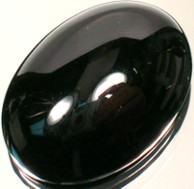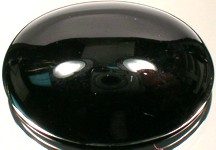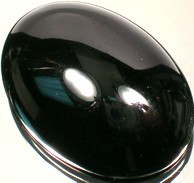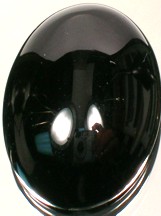












Antique 18th Century Genuine Natural Eight Carat Hand Crafted/Polished Siberian Agate Semi-Precious Gemstone Oval.
CLASSIFICATION: Polished Siberian Onyx Polished Cabochon.
ORIGIN: 18th century Russia.
SIZE: Length: 18mm. Width: 13mm. Depth (Thickness): 5mm. Measurements approximate.
WEIGHT: 8.05 carats.
NOTES: Upon request we can set your gemstones as a ring, pendant, or as earrings (click here for more information).

DETAIL: Ancient Greek and Roman soldiers often wore a talisman of onyx, as it was believed that doing so would instill a sense of bravery in the soldiers. Oftentimes the talismans worn by Roman soldiers were carved with images of Hercules or Mars, the Roman God of War. Ancient historical accounts record that the Roman general Publius Cornelius Scipio (who defeated Hannibal at Carthage) frequently wore this gemstone. Onyx became particularly famous in the hands of both the Greeks and Romans, who as described by the first century Roman historian and naturalist “Pliny the Elder”, crafted beautiful intaglio seals out of onyx. In Greco-Roman Mythology, onyx was believed to originated from the fingernails of Venus, the Goddess of Beauty. In the ancient world, onyx was oftentimes more costly than either gold or silver, and one ancient reference recorded it as more valuable than sapphire.
Celebrating our cultural inheritance here's an antique handcrafted Siberian black onyx cabochon cut gemstone. In the ancient world Persian magicians were believed to possess the power to divert storms through the use of agate talismans of various species (including onyx). Many forms of agate, including onyx, have been popularly used through recorded history for the production of jewelry, beads, and amulets due to the vibrant rainbow of colors agate naturally occurs in. Agate amulets produced by Stone Age man in France has been discovered, dating the known use of agate back to approximately 20,000 B.C. Agate was widely used and admired by the ancient Romans, Greeks, Phoenicians, Persians, Egyptians, etc.

Hand crafted by an 18th century Russian artisan, part of an heritage renown for the production of the elaborate gemstones and jewelry of the Czars of Medieval, Renaissance, and Victorian Russia. Originally used in indigenous jewelry, this particular specimen is of very nice quality, very beautiful. As might be expected under magnification the gemstone shows the unmistakable, hallmark characteristics of having been hand crafted. The coarseness of the 18th century finish is considered desirable to most gemstone aficionados, and is not considered a detriment, or detract from the value of a gemstone. These characteristics are not only expected of hand-finished gemstones, many believe that such antique hand-crafted gemstones possess much greater character and appeal than today's mass-produced, machined gemstones. Unlike today’s computer controlled machine produced gemstones that approach flawlessness in a perfect finish, the cut and finish of an antique, handcrafted gemstone such as this is the legacy of an artisan who lived two centuries ago.
Handcrafted though it may be the gemstone possesses great luster and character, but that is not to imply that it is absolutely flawless. True, the blemishes it possesses are virtually invisible to the naked eye, and to the view of the casual admirer the gemstone is indeed seemingly without blemish. However in the accompanying photo enlargements you might be able to discern a few minute blemishes as well as occasional irregularities in the cut and finish. Naturally much the same may said about almost any antique, handcrafted gemstone of natural origin. Most absolutely flawless gemstones will upon close examination be revealed to be synthetic. Furthermore these characteristics are not only expected of hand-finished gemstones, you must also consider that two centuries ago the mining techniques even possible then, let alone in practice, did not allow the ultra deep mining operations which are so commonplace today.

Keep in mind two centuries ago mankind was more or less limited to surface deposits or near surface deposits of gemstones. Higher quality gemstones which today are routinely mined from beneath hundreds of meters, even kilometers beneath the earth's surface, were simply inaccessible then. It is precisely for these reasons antique gemstone must be appreciated as antiques first, gemstones second. The relatively superlative quality of contemporary gemstones mined from deep beneath the earth's surface were simply not accessible two centuries ago, or at least, only rarely so. But for most, the unique nature and character of these antique gemstones more than makes up for the blemishes found within the gemstones, as well as the cutting and finishing irregularities common to handcrafted gemstones, all of which are by and large are only visible under magnification.
HISTORY OF ONYX: Onyx is the name for the black (most often with white banding) variety of chalcedony. It has been used since antiquity where it was highly prized as a cameo stone. The layered color structure allows the engraver to cut the subject in one color while creating a background of another. According to Greek Mythology, the origins of onyx are traced to the Goddess Venus’s fingernails. One day when Venus (the Greco-Roman Goddess of Beauty) lay asleep the mischievous Cupid (her son and the God of Love) cut her fingernails and flew away leaving the fingernail clippings scattered on the ground. Because no part of a deity could be permitted to die, the gods turned the fingernail clippings into stone which later became known as onyx.

In fact the name “onyx” draws its origin from the Greek language in which “onux” means fingernails. In the ancient world, onyx was oftentimes more costly than either gold or silver, and one ancient reference recorded it as more valuable than sapphire. Onyx was used in ancient Egypt as early as the Second Dynasty (about 2800 B.C.) to make bowls and other items. Onyx also was amongst the artifacts recovered of Minoan Crete (about 1800 B.C.), notably from the archaeological discoveries at Knossos. Onyx became particularly famous in the hands of both the Greeks and Romans, who as described by the first century Roman historian and naturalist “Pliny the Elder”, crafted beautiful intaglio seals out of onyx (see a spectacular first century example here).
Ancient Greek and Roman soldiers often wore a talisman of onyx, as it was believed that doing so would instill a sense of bravery in the soldiers. Oftentimes the talismans worn by Roman soldiers were carved with images of Hercules or Mars, the Roman God of War. Ancient historical accounts record that the Roman General Publius Cornelius Scipio (who defeated Hannibal at Carthage) frequently wore this gemstone. The Romans also believed that wearing onyx would enhance the growth of fingernails and regenerative skin growth. In nearby ancient Persia onyx was used by sorcerers and shamans who believed it enhanced intuition. In ancient India onyx was believed to calm the ardors of love, a belief which eventually was picked up by the Western World where onyx had the reputation of decreasing sexual desire.

The ancient Hindus also wore onyx to protect against the evil eye as it was believed that onyx had a trapped demon within. To the ancient Chinese, onyx was known as the "stone of sadness", and it was believed that even entering a mine where onyx was found might lead to terrifying dreams, doubts, and disputes. Onyx was also known to the ancient Hebrews. According to Genesis, onyx was found in the land of “Havilah”, "where the gold is", thought to refer to Egypt or Arabia. A precious commodity in Old Testament times, onyx is also mentioned frequently in the Bible, such as "Job regarded God's wisdom as a greater possession than even costly onyx." Onyx is also frequently cited as one of the twelve stones in the breastplate of the High Priest, Aaron, representing the twelve tribes of ancient Israel.
In the Medieval World onyx was believed useful in aiding the wearer to cure bad habits, and to help the wearer retain strength. However the beliefs of the ancient Chinese had spread to Europe by the Middle Ages, and onyx was also believed by many to bring bad luck, sadness, fear and images of madness in sleep, as well as to create discord and dispute. Medieval shamans and magicians believed that onyx would protect against misfortune and illness, and would prevent illusions, nightmares and confusion caused by evil spirits. Onyx was often used in magic to contact spirits of the dead, and as an aid to recall memories and visions of past lives. It was believed to “soften” barriers between the worlds, allowing travel between different planes of existence.

Shamans also believed that the stone could be used to summon friendly spirits to guide a dying soul on its journey to the next world. An onyx sphere was believed to protect the owner by providing a warning of impending danger. In the Renaissance onyx was believed to fill the wearer with a gift of eloquence (and was regarded with great value by public speakers and orators), particularly when expressing his or her love to a new romantic interest. It was also worn with the belief that it helped increase concentration and sharpen the wearer’s wits, and was also worn to enhance one’s spiritual inspiration. Onyx was also believed to bring unexpected good luck and opportunity to its owner and to protect them from the plots and ill wishes of their enemies.
Onyx is a variety chalcedony quartz, part of the agate family, and is formed in the gas cavities of lava. Generally the stone is black or black with white banding. Some onyx displays white and lighter reddish bands or ribbons against a brown background, this variety is known as sardonyx. When the onyx has a red base, it is known as carnelian-onyx. Throughout the history of the ancient world, gemstones were believed capable of curing illness, possessed of valuable metaphysical properties, and to provide protection. Found in Egypt dated 1500 B. C., the "Papyrus Ebers" offered one of most complete therapeutic manuscripts containing prescriptions using gemstones and minerals. Gemstones were not only valued for their medicinal and protective properties, but also for educational and spiritual enhancement.

In the ancient world it was believed that onyx gave courage and bravery to the wearer, would warn the wearer of impending danger, would enhance the intuitive and prophetical abilities of sorcerers and magicians, would act as a guide to the souls of the deceased, would enable mediums to communicate with the dead and recall past lives, would protect against the “evil eye”, and would also cool the flames of sexual desire. It was also believed to enhance the growth of fingernails and skin, to enhance intelligence and the ability to concentrate, would help the wearer break bad habits, enhance the wearer’s oratorical abilities, and would protect the wearer from evil spells and nightmares.
Modern practitioners believe that onyx is useful in healing old emotional wounds and enabling the wearer to move ahead by forgetting the past experiences of bad relationships, and as well help form new romantic relationships by improving expressive abilities between lovers. For absent-minded people onyx is regarded as being very helpful in increasing concentration levels and calming the mind amidst the chaotic conditions of modern life, even so far as being recommended for the treatment of various neurological disorders. Some modern practitioners claim that onyx can help physical ailments such as hearing problems, heart trouble, and ulcers. It is also believed to encourage new hair growth for those suffering from baldness, and is also believed an aid to those who are trying to break bad habits. Onyx is also said to lend comfort in unfamiliar surroundings, alleviating feelings of loneliness and alienation.

ADDITIONAL PURCHASES do receive a VERY LARGE Your purchase will ordinarily be shipped within 48 hours of payment. We package as well as anyone in the business, with lots of protective padding and containers.
We do NOT recommend uninsured shipments, and expressly disclaim any responsibility for the loss of an uninsured shipment. Unfortunately the contents of parcels are easily “lost” or misdelivered by postal employees – even in the USA. If you intend to pay via PayPal, please be aware that PayPal Protection Policies REQUIRE insured, trackable shipments, which is INCLUDED in our price. International tracking is at additional cost. We do offer U.S. Postal Service Priority Mail, Registered Mail, and Express Mail for both international and domestic shipments, as well United Parcel Service (UPS) and Federal Express (Fed-Ex). Please ask for a rate quotation. We will accept whatever payment method you are most comfortable with. If upon receipt of the item you are disappointed for any reason whatever, I offer a no questions asked return policy.

We travel to Russia each year seeking antique gemstones and jewelry from one of the globe’s most prolific gemstone producing and cutting centers, the area between Chelyabinsk and Yekaterinburg, Russia. From all corners of Siberia, as well as from India, Ceylon, Burma and Siam, gemstones have for centuries gone to Yekaterinburg where they have been cut and incorporated into the fabulous jewelry for which the Czars and the royal families of Europe were famous for. My wife grew up and received a university education in the Southern Urals of Russia, just a few hours away from the mountains of Siberia, where alexandrite, diamond, emerald, sapphire, chrysoberyl, topaz, demantoid garnet, and many other rare and precious gemstones are produced. Though perhaps difficult to find in the USA, antique gemstones are commonly unmounted from old, broken settings – the gold reused – the gemstones recut and reset.
Before these gorgeous antique gemstones are recut, we try to acquire the best of them in their original, antique, hand-finished state – most of them centuries old. We believe that the work created by these long-gone master artisans is worth protecting and preserving rather than destroying this heritage of antique gemstones by recutting the original work out of existence. That by preserving their work, in a sense, we are preserving their lives and the legacy they left for modern times. Far better to appreciate their craft than to destroy it with modern cutting. Not everyone agrees – fully 95% or more of the antique gemstones which come into these marketplaces are recut, and the heritage of the past lost. But if you agree with us that the past is worth protecting, and that past lives and the produce of those lives still matters today, consider buying an antique, hand cut, natural gemstone rather than one of the mass-produced machine cut (often synthetic or “lab produced”) gemstones which dominate the market today.

Our interest in the fabulous history of Russian gemstones and the fabulous jewelry of the Czar’s led to further education and contacts in India, Ceylon, and Siam, other ancient centers of gemstone production and finishing. We have a number of “helpers” (family members, friends, and colleagues) in Russia and in India who act as eyes and ears for us year-round, and in reciprocity we donate a portion of our revenues to support educational institutions in Russia and India. Occasionally while in Russia, India, Siam, and Ceylon we will also find such good buys on unique contemporary gemstones and jewelry that we will purchase a few pieces to offer to our customers here in America. These are always offered clearly labeled as contemporary, and not antiques – just to avoid confusion. We can set most any antique gemstone you purchase from us in your choice of styles and metals ranging from rings to pendants to earrings and bracelets; in sterling silver, 14kt solid gold, and 14kt gold fill. We would be happy to provide you with a certificate/guarantee of authenticity for any item you purchase from me. Please see our "ADDITIONAL TERMS OF SALE."

